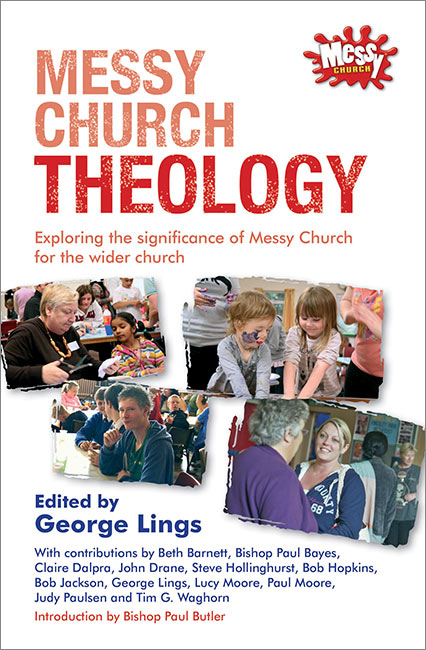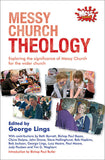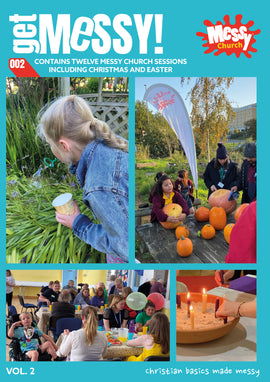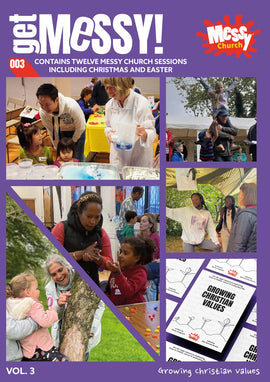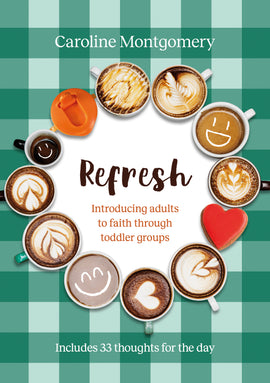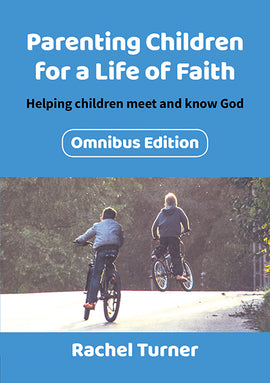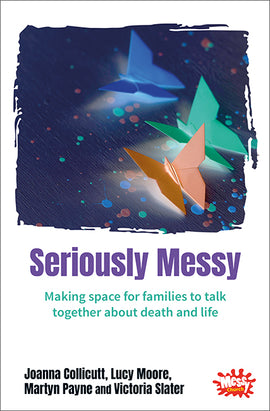Messy Church Theology: Exploring the significance of Messy Church for the wider church
Messy Church Theology is the first title to encapsulate the theology of Messy Church. Through essays by contributors from a variety of church and academic backgrounds and case studies by Messy Church practitioners, it gathers together some of the discussions around Messy Church and assesses the impact of this ministry, placing it in the context of wider developments within the church community.
| Title | Messy Church Theology: Exploring the significance of Messy Church for the wider church |
| Edited by | George Lings |
| Description | Messy Church Theology is the first title to encapsulate the theology of Messy Church. Through essays by contributors from a variety of church and academic backgrounds and case studies by Messy Church practitioners, it gathers together some of the discussions around Messy Church and assesses the impact of this ministry, placing it in the context of wider developments within the church community.
Section 1: Messy questions
Section 2: Messy foundations
Section 3: Messy practicalities
|
| Details |
|
Messy Church Theology is the first title to encapsulate the theology of Messy Church. Through essays by contributors from a variety of church and academic backgrounds and case studies by Messy Church practitioners, it gathers together some of the discussions around Messy Church and assesses the impact of this ministry, placing it in the context of wider developments within the church community.
- Introduction
Section 1: Messy questions
- 1 When is Messy Church 'church'?
Claire Dalpra - 2 When is Messy Church 'not church'?
Steve Hollinghurst - Case study: Messy Church Special Educational Needs
Trish Hahn - 3 How does Messy Church travel?
Lucy Moore - 4 Does Messy Church make disciples?
Judy Paulsen - Case study: Messy Church at St Christopher's
Alison Paginton
Section 2: Messy foundations
- 5 Messy theology
Paul Bayes - 6 Messy disciples
John Drane - Case study: Messy Church Fiesta
Christine Barton - 7 From Sunday school to Messy Church: a new movement for our age?
Bob Jackson - 8 What is the DNA of Messy Church?
George Lings - Case study: Messy Church @ Christ Church Primacy
Kevin Metcalfe
Section 3: Messy practicalities
- 9 Messy maturity: paradox, contradiction or perfect match?
Beth Barnett - 10 Messy Church: how far can you go before reaching the limit?
Tim G. Waghorn - Case study: the story of the 'Messy angels'
Sharon Pritchard - 11 Some frameworks to explore Messy Church and discipleship
Bob Hopkins - 12 Growing, maturing, ripening: what might an older Messy Church look like?
Paul Moore - Case study: St Andrew's Church, Bebington: the journey of an older Messy Church
Marie Beale - 13 Why we might expect mess, not merely tolerate it
George Lings - Afterword
Lucy Moore
Ministry Today - July 2016
This is a fairly substantial assessment of where Messy Church is up to and how it might sit within the wider church, and because Messy Church is inter-generational, there is much in these 13 chapters that could apply to All Age Worship of any kind.
Key recurring issues are: 'Is Messy Church really church, or is it just a part of church?'; 'Does Messy Church really disciple people adequately?'; 'How adaptable is Messy Church?'; 'What is the future of Messy Church?' Obviously the book is a forthright apologia for Messy Church. Most, but not all, contributors firmly claim that Messy Church is (or should be viewed as) a full expression of church in its own right. Certainly, it's pointed out, if the Vicar thinks it is merely a strategy to get people into 'real' church and the Messy Church Leaders feel it's a full expression of church in its own right, you are heading for trouble!
There is much here for All Age practitioners to reflect upon, especially in the area of discipleship. However, stronger answers still need to be developed. What's really good is that the Messy Church movement has asked searching questions of itself, and offered some answers with case-studies. 3.5/5.
Richard Dormandy
Review from Ecclesial Practices 2:1 (2015), 121-123] - Australia May 2015
Messy Church is a creative, all-age, hospitable, celebrating expression of church whose time seems to have come. A decade on from its pioneering by Lucy and Paul Moore and team in Portsmouth, there are now 1400 registered messy churches in the UK alone, and Messy Church coordinators estimate 4000 Messy-style churches with 360,000 participants in the UK. It is the single most common and most rapidly multiplying expression model of the Fresh expressions movement, and is connecting with un-churched, de-churched and marginally churched people. Its reach has spread across denominations and continents; the Messy Church website directory shows me there are 20 in my home city of Melbourne, including 3 within 3 kilometres of my house - Anglican, Uniting and Baptist! There are more than a dozen books on how to start and run a messy church with its crafts, cooking and conversations. What Messy Church Theology uniquely explores is where Messy Church fits theologically as 'church', where it is growing (or wants to grow) in disciple-making, and what other streams of the church and missional movement could learn from Messy Church.
19 writers contribute case studies or chapters in three sections. Firstly there are 'messy questions' exploring when fresh expressions are fresh, when they are church, and when they are messy church? What is the DNA of messy church, how transferable is it, and how does Bible Reading Fellowship as its sponsor ensure quality but not expect control? The most recurring questions are how can Messy Church foster discipleship, and how can it 'be church' for all-of-life beyond certain life stages. It is appropriate to bring an evaluative grid to innovative new expressions about how they are doing as church in making healthy disciples and being missional, but these are questions for all churches not just messy new experiments.
The second section digs into 'messy foundations' - urging a theology and discipleship that is messy and curious. That is helped as we listen to and not just condescend children, and celebrate and imitate their relentless and playful questioning. Messy Church, like Alpha, allows space for questions and expressing mystery and doubt; elements that are essential for evangelism in a post-modern context, but natural in an all-age setting of Messy Church. The ethos of creativity that Messy Church fosters is intriguing and something all churches could learn from, as George Lings articulates:
'Turning church back into a creative, participatory, communal hive of spiritual life is a worthy goal that critiques much existing church practice. Through true hospitality and creativity, those who come to us move from being clients, for whom we provide pre-cooked liturgical dishes, to being guests for whom we care. They also become co-creators with whom we are fellow artists, and co-workers with whom we are partners. In the end, even the distinction between host and guest dissolves, and so all-age, Christ-centred community emerges' (pp.160-161).
The third and final section unpacks 'messy practicalities'; not trying to tidy up all loose ends but actually celebrating the mess of life and the adventure of experimenting with church. For example, Beth Barnett offers critique of Western Enlightenment-inspired 'maturity' language, pointing more importantly to Jesus' invitation to become like a child in openness, collaboration and curiosity (rather than aspiring to power, bigness and conservatism). Barnett subversively suggests multi-sensory interactive learning and engaging together with Scripture is potentially a richer and more promising path to growth than a three point monological sermon; and that engaging with Scripture and worship with children ought to be as natural as children around the dinner table.
There is a rich collection of case studies scattered through the book, but I especially appreciated Tim Waghorn's Melbourne innovation of offering weekly (rather than the usual monthly) Messy Church as a way of breaking down barriers and offering church accessibly for families, complete with media-guided worship (using common technology people are used to) and sensory engaging learning. Waghorn celebrates how Messy Church involves a wide range of lay leaders and does not rely on the hired holy person, but he also challenges Ministers to engage in Messy Church leadership, as a fast-track way of connecting and being accessible.
Convinced as I am that we desperately need more innovative and colourful expressions of church that are shaped around mission, there are important lessons to learn from Messy Church. We can continue to develop and multiply Messy Churches, but also boldly reinvent church in other surprising directions and reshapings. We need the kind of courage and creativity that characterizes Messy Church, but also the permission and resourcing that existing churches and sponsors have generously given. We need to unleash the creativity of all of God's people, and not be preoccupied with a particular inherited worship format or bound by reliance on hired holy people. As we experiment, messy does not mean sloppy as George Lings warns, and churches need to be careful about focusing on and evaluating discipleship and mission and our foundational values, as the Messy Church Theology authors have done.
I have my own unanswered curious question to ask of these Messy Church Theology writers. Their concern about discipleship seems to largely settle on utilizing and the 10 minute celebration teaching time, or increasing the frequency of gathering or adding extra programs or resources. But I would love to hear more about how Messy Church practitioners utilize their craft and hospitality times for disciple-making. What can we learn - or what do we need to learn better - about coming alongside people in the midst of activity and relationships, and as spiritual companions urging one another on as disciples? In what ways can we best be open to 'God moments' that Paul Moore urges us to be attentive to (p.243) in the midst of the 'create, chill, chomp and celebrate' (p.259) of Messy Church, or even everyday life?
The rich theological reflection, practical suggestions and inspiring case studies of Messy Church Theology is excellent reading for Messy Church practitioners, anyone having a go at all-age worship or outreach, or missional church leaders ready to learn from this growing movement.
Darren Cronshaw, pastor of AuburnLife and Mission Catalyst - Researcher with the Baptist Union of Victoria.
This is another well-presented, easy to read book from the Messy Church team.
Several themes recur in the book. It inevitably considers the wider debate of Fresh Expressions of which Messy Church can be considered one aspect. Claire Dalpra and Steve Hollinghurst debate whether Messy Church is or is not 'church', with the theme reiterated throughout the book that Messy Church is not just another activity club, Sunday school or outreach project. To be 'church' it needs to demonstrate the four creedal marks of church: one, holy, catholic and apostolic.
The debate around Fresh Expressions inevitably raises the issue of how adults can grow as disciples within Messy Church. Judy Paulsen uses data from her doctoral research study to look into this in some depth. Tim G. Waghorn suggests that although the teaching context should be robust and relevant to connect with families, adults are likely to be kept in a 'holding pattern' until there is something else for them to feed into. Bob Hopkins discusses a framework to make discipleship more intentional, while Beth Barnett proposes that it might not be necessary to consciously strive for maturity if the congregation enjoys a constant engagement with the Bible and the Holy Spirit.
George Lings suggests that Messy Churches should be measured against the core values identified by Lucy Moore: hospitality, creativity, celebration and all-age, adding a fifth: Christ-centred.
The book is punctuated with case studies of individual Messy Church experiences, from the Messy Church Fiesta in Scotland, the 'Messy Angels' in Northern Ireland to the Messy Church in Hemel Hempstead for children with special needs and the Messy Church in the north-west of England with some useful ideas for reaching dads and engaging the boys. These all provide a useful snapshot of recent Messy Church developments.
As with all books of this style, there are some articles that are more useful than others. But each of the varied selection of authors has written passionately about their different areas of expertise, providing some thought-provoking material. They look back on the story so far, celebrating what God has been doing, and looking ahead to debate what might make Messy Church even more effective for the future.
Gillian Roberts
From STAR News late September 2014
'...the people group who have been theologically marginalised and ignored the longest and most consistently to the present day are children. Week by week in our churches we continue to patronise them, silence them and ignore their attempts at reframing our faith. If they are asked to share their thinking at the end of our Sunday worship, we applaud their insights into the holy scriptures rather than learning from them. And yet, if we will look and listen, the drawings and sculptures and ideas and thinking of children in every church can enormously enrich what we know about God.'
This explosive paragraph, by Bishop Paul Bayes, is in line with the thought-provoking material written by all of the varied authors featured in this first-rate book. Read it if you are involved in the leadership of a Messy Church or if you want to deepen your understanding of how anyone can be helped to grow as a disciple of Jesus.
I will be referring to it often!
Rona Orme - Peterborough Diocese Children's Missioner.
From Salvationist, 7th June 2014
I AM naturally more at home preparing and doing Messy Church than I am 'theologising' about it! That being said, reading Messy Church Theology has given me insight into what has made Messy Church the phenomenon it has become over the past ten years.
While the heart of Messy Church itself is all about introducing families to Christ, the various contributors to this book seek to answer questions such as, 'When is Messy Church, church?' and 'Does Messy Church make disciples?' Some of the questions raised and concerns highlighted are very much rooted in its Anglican heritage and their use of liturgy and the sacraments. However, while these may not pose the same issues for The Salvation Army, most of us would be challenged that it should not be seen as just a bridge to our Sunday meeting congregations but as a church in its own right. I particularly enjoyed Paul Moore's analogy of likening church to the variety of Cheddar cheeses available in a supermarket: 'The mild looks like soap and probably tastes bland. The vintage looks cracked and crusty and may prove dangerously pungent but the point is that it is all sold as Cheddar cheese and it is all maturing. Similarly, in a healthy maturing church we can expect to have a range of Christian commitment and maturity, from new Christians through to vintage disciples, and even if there are more mild than mature members, it still constitutes real church if the members are working together to build one another up in Christ.'
Although tough at points, the overall read is worthwhile and will prove beneficial to anyone involved in leading Messy Church. Case studies give inspirational examples of good practice and tie the book together in showing how Messy Church successfully reaches people with the love of God.
Review by Rachel Gotobed
From Mission Network News
After nearly 10 years Messy Church has grown considerably, with over 2000 churches registered worldwide. Such growth has generated much response and debate. A collection of essays from a range of contributors has been gathered in order to provide theological reflection that will explore the significance of Messy Church for individual discipleship and for the wider church. Any who wish to engage in a broader awareness of this, or who are questioning the long-term sustainability and impact of Messy Church, will find that the essays provide a framework for thought and debate.

